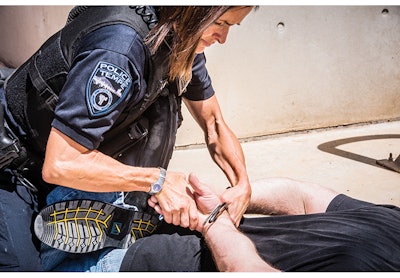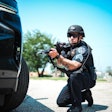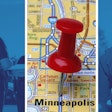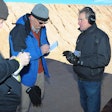 Photo courtesy of iStockPhoto.
Photo courtesy of iStockPhoto.
Upon their arrival at the 1950s-era one-story bungalow on Wehner Lane, they contacted the informant, Helen Perez. She advised them that her brother, Albert Belmontez, was drunk and high on drugs. This was not atypical behavior on Belmontez's part, but this night the ensuing amount of destruction he'd caused was unusual. Perez had been kicked in the leg and their shared home had been torn up, but what sealed her decision to order her brother to leave was that he had thrown a large bottle with Nolan Ryan-like intensity at her as she stood in the street. Unfortunately, he didn't leave; he holed himself up inside their home. And she called the deputies.
Making Contact
The house was nestled among the foothills of the San Gabriel Mountains and the sun had retreated from view hours before. With curtains blocking the little ambient lighting that streamed in from outside the house, Brown and Keating were hard-pressed to get a glimpse of the disturbing party. Nonetheless, they attempted to call out to him.
Their efforts periodically triggered profanity-laced replies from the 27-year-old man, but little more. Forty minutes after the deputies' arrival, Belmontez turned off the interior lights.
The two deputies elected to try to contact the man by opening a window, a decision bolstered by the informant's assurance that Belmontez would not be near the window. Approaching an unlocked window to the right of the front door, Brown removed the screen and slowly pried the window open as Keating kept vigil to his right. Again, their calls to the suspect to come out were met with silence.
Suddenly, a hand shot through the curtains and seized Brown's uniform shirt. Belmontez yelled, "You're not going to open my window!"
Keating's reaction was fast; he struck the unseen arm with his flashlight. Brown struggled to release himself from the man's grasp, and his uniform shirt tore as he backed away from the window. Belmontez let out a string of profanities and closed the window, causing Keating's flashlight to smash through the glass. An upright shard dug into Keating's arm and wrist, severely lacerating both. Blood splashed about the window and both deputies backed away.
As the informant applied direct pressure to Keating's cuts, her brother came to the front door. Brown had anticipated correctly that the man was about to step out of the house and had drawn his PR24 baton from his Sam Browne seconds before. What he had not anticipated was that Belmontez would exit carrying a 12-inch-long kitchen knife by his right leg.
Coming Out
"He's got a knife!" Brown yelled to Keating, who stood a few feet off to his right. But Keating's injuries had left the deputy incapable of immediately addressing any threat, leaving Brown effectively on his own. Transitioning from his baton to his Beretta 92F, Brown yelled for Belmontez to freeze and drop the knife.
Instead, Belmontez raised the knife and charged at the officers with rapid steps. That the man had a wooden leg had already been made known to Brown. What he didn't expect was that the 250-pound man had long ago become accustomed to walking with it, and whatever degree his intoxication might have affected his coordination, it did not diminish his speed. The 15-foot buffer zone Brown had created in backing away from the location was rapidly diminishing as the knife-wielding man charged down the steps at him.
"I'm going to kill you!" Belmontez hissed.
Brown didn't need to be warned a second time. He'd received enough training from his department to understand the dangers posed by knife-wielding suspects and seen the images of eviscerated lawmen who'd failed to respect such threats in the past.
Brown had backed up as far as the fenced yard would allow. At the sight of Belmontez lunging toward him, Brown began squeezing off rounds from his Beretta. He fired a rapid volley, striking the man 10 times in the head, neck, torso, thigh, and back. Belmontez's body collapsed at Brown's feet.
Civil Unrest
Belmontez's neighbors began pouring into the street. And over the next hour, deputies from Brown's home station and three neighboring stations would be descending upon a scene of chaos as the neighborhood devolved into an impromptu act of civil unrest.
Retaining any semblance of order may have been problematic, but one thing was certain to Brown's mind. Wild horses couldn't pull him away from the suspect's side because he knew that the knife would disappear otherwise.
In the days that followed, American flags flying at half-staff became a familiar sight on the street where Belmontez had lived. Friends and neighbors of the family helped raise more than $1,000 to help with burial costs and pay for a private investigator and claims were filed against the Los Angeles County Sheriff's Department for negligence and excessive force.
Law enforcement critics often cite the ratio of misses to hits in officer-involved shootings as indicators of both a blood-thirsty nature and a paranoid response on the part of the officers. In this instance, the number of hits and the proximity in which they were fired were indicted by self-proclaimed judges who characterized Dep. Brown as a man who'd gunned down a one-legged man who "was probably trying only to balance his prosthesis."
"If an officer can shoot somebody 10 times like this, I don't think he has any business being on the street," said Robert W. Thompson, the family's attorney and director of the Inland Empire Victims' Rights Center. "To me, that's just outrageous."
For its part, the department was assertive in defending Brown's use of deadly force—at least to the news media.
"They shot him in self-defense," said Sgt. Gil Aguilar at the time. "It's an instantaneous type thing, a reaction ... to a deadly situation."
The deadliness of the situation was corroborated by several neighbors who heard the deputies telling Belmontez to put down the stainless steel kitchen knife, as they watched the events unfold from their respective homes.
This wasn't Belmontez's first brush with the law either. As a teenager, he had been convicted and had served more than a year for being an accessory to a drive-by shooting aimed at the San Dimas sheriff's substation. One neighbor complained that Belmontez had caused commotion in the neighborhood at least 10 times during the prior three months.
Settling the Case
Tactically the incident had been affected by the technology of the day. The shooting occurred just before commonly held communication devices and a wide array of less-lethal weaponry. Brown says that things might well have ended differently in this era; he certainly hopes so.
"I wished that we could have called the Special Enforcement Bureau, but that wasn't an option for different reasons," Brown reflects. He candidly assesses one tactic that he wishes he hadn't employed in the hopes that others will think twice before attempting a similar tack. "My mistake was I should not have opened that window," he says. "It was a complete unknown; he could have had an AK-47 in there."
As far as the shooting itself, Brown says that he is as comfortable with it as he possibly can be, even with its attendant lawsuit. His description of his emotional response to the threat is typically candid.
"Because of the fear-induced adrenaline I actually saw the bullet leave my gun," says Brown. "I saw it go up his left front orbital temple area. I thought, 'Thank goodness, that's not a bad shot.' It was my intended target because of all the training I'd been exposed to regarding knife threats, including videos and photos of situations where cops were confronted with knives and the wrong guy ended up going to the morgue. I wasn't going to be that guy. There was no way in hell that I wanted to get killed by a knife. I'd rather be shot by a gun. And that idea has little appeal to me, either."
But opportunistic lawyers saw prospective litigation in the fact that Brown had used a gun to kill a one-legged man with a knife. Determined to make good on it, they filed suit against the County. Whatever the merits of their case, they were perhaps gambling on what came to pass: A "let's get rid of it" mentality on the part of the County saw it settling with the family out of court to the tune of $750,000.
Brown wishes the County hadn't settled, particularly as he revisits the image of Belmontez's sister, Helen Perez, seated in the courtroom holding a Bible between her knees and deeply contemplative before rebutting the litigating attorney's insinuation that her brother had not exited the house holding the knife.
Talking About It
Dep. Michael Keating was medically retired because of the injuries to his hand and arm. In less than a decade, Brown would join him as a direct result of a separate shooting.
Since his retirement, Brown has become attuned to law enforcement officers and military servicemen who deal with PTSD. A continued source of concern for Brown is the silence that is imposed upon officers who have been involved in shootings. In this instance, as in hundreds of others, Brown was sequestered away from others, his weapon taken away, and he was told not to discuss the shooting with anyone in any context.
"You don't go through something like this without wanting and needing to talk about it," says Brown. "You want to share what you learned with others so that they can possibly prevent unnecessary situations and be better able to cope with those that do occur." For Brown, this one-size-fits-all litigation-driven policy exacerbates stresses already inherent to such situations.
Brown now hopes that by speaking more freely about his experiences, he can make a difference for others.
What Would You Do?
Put yourself in the shoes of Los Angeles County Sheriff's Dep. Walt Brown and Dep. Michael Keating. It's 1989 and you have been called to a domestic disturbance. Now ask yourself the following questions.
This shooting occurred at a time when deputies were still obligated to run back to their patrol units to request assistance when force options were more limited. Allowing for what is available today, how would you deal with a knife-wielding suspect when hemmed in a yard line by a fence? Do some situations require the same manner of response, irrespective of era?
Fears of evidence retrieval or destruction weighed heavily on Dep. Brown's mind in the seconds following the shooting. In the aftermath of a deadly force incident occurring in a "hostile" environment, what would your personal priorities be? What logistics might you call upon?
Brown openly regrets the decision to open the window. What other strategic or tactical options might you explore?
Cop critics love to Monday morning quarterback the number of rounds fired in an officer-involved shooting, and cited Brown's as excessive, despite the fact that the suspect was still able to fall at his feet. In light of a recent Missouri-based shooting where it took more than 70 hits to down a determined suspect, is there such a thing as an excessive number of rounds that can be fired? What are your criteria?
















